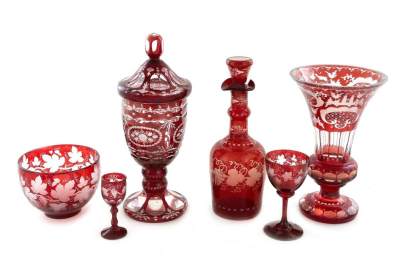A Gem in the World of Glass
Ruby glass has fascinated artisans, alchemists, and collectors for centuries. With its deep red hue resembling precious gemstones, this remarkable glass was once shrouded in secrecy. From its accidental discovery to its role in royal tableware and modern optics, ruby glass remains a marvel of chemistry and craftsmanship.

The History: From Alchemists to Industrial Masters
The story of ruby glass dates back to the 17th century when European alchemists were obsessed with turning base metals into gold. While their quest for gold failed, they stumbled upon something equally stunning—glass infused with gold nanoparticles, creating a vibrant red color.
The credit for the first true ruby glass is often given to Johann Kunckel, a German chemist and glassmaker. In the late 1600s, he successfully developed a repeatable process to produce ruby glass by adding gold chloride to molten glass. However, he was secretive about his methods, making it a closely guarded craft.
Later, during the 19th century, more advanced techniques were developed to create ruby glass on a larger scale. Scientists like Michael Faraday further studied the role of nanoparticles in glass coloration, laying the groundwork for modern materials science.
The Making of Ruby Glass: A Delicate Process
Creating ruby glass is an art that requires precision. The process involves:
- Gold Infusion: A tiny amount of gold chloride or colloidal gold is added to molten glass.
- Careful Heating: The glass must be heated at high temperatures and then cooled in a controlled way to develop the characteristic red hue.
- Striking the Color: The deep ruby shade doesn’t appear immediately; it requires reheating to bring out the rich tones, a process known as "striking."
- Shaping and Polishing: Once the glass achieves the perfect shade, it is molded, blown, or cut into various forms, from fine goblets to intricate lamps.
The color intensity depends on the gold particle size—larger particles yield a darker red, while smaller ones create a lighter, pinkish tone.
A Funny Side Story: The Accidental Alchemist’s Dilemma
One of the most amusing legends surrounding ruby glass involves Kunckel himself. He reportedly worked in secrecy on an island in Germany, fearing that rivals or even the authorities might steal his process. The rumor goes that a clumsy assistant once added too much gold to a batch, resulting in an unusually dark red glass. Instead of discarding it, Kunckel decided to experiment and accidentally discovered that reheating could adjust the shade. This "lucky mistake" led to a more refined technique for controlling ruby glass color.
The Meaning of Ruby Glass Today
In modern times, ruby glass continues to be a symbol of luxury, craftsmanship, and history. It is used in:
- Fine Glassware & Antiques: Collectors prize vintage ruby glass, especially 19th-century Bohemian pieces.
- Optics & Science: Ruby-colored glass is used in laser technology, filters, and protective lenses.
- Decor & Jewelry: Artists still create stunning ruby glassware, often for high-end tableware and lamps.
Despite new synthetic methods for coloring glass, traditional gold-based ruby glass remains highly valued for its unique depth and brilliance.
Fascinating Facts About Ruby Glass
- It’s literally gold-infused. The red color comes from gold nanoparticles suspended in the glass.
- It was once considered "magic." Early chemists believed they had discovered a mystical formula when they saw molten glass turn red.
- Some royal families had exclusive rights. In the 18th century, ruby glass was so rare that only nobility could afford it.
- It can take days to develop the perfect shade. The color transformation requires careful heat treatment.
- A fake version exists. Some modern ruby glass is made with selenium or copper instead of gold, but purists insist that real ruby glass contains gold.
Conclusion: The Fiery Elegance Lives On
Ruby glass stands as a testament to the intersection of science and artistry. From its secretive beginnings in the workshops of alchemists to its use in modern optics and luxury décor, it continues to captivate admirers worldwide. Whether in an antique goblet or a scientific instrument, this glass remains one of the most beautiful alchemical accidents in history.